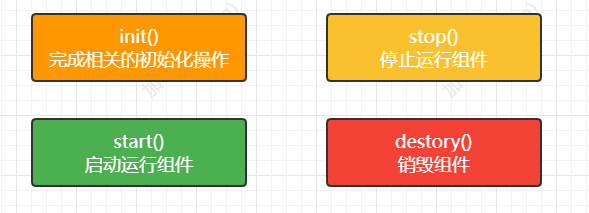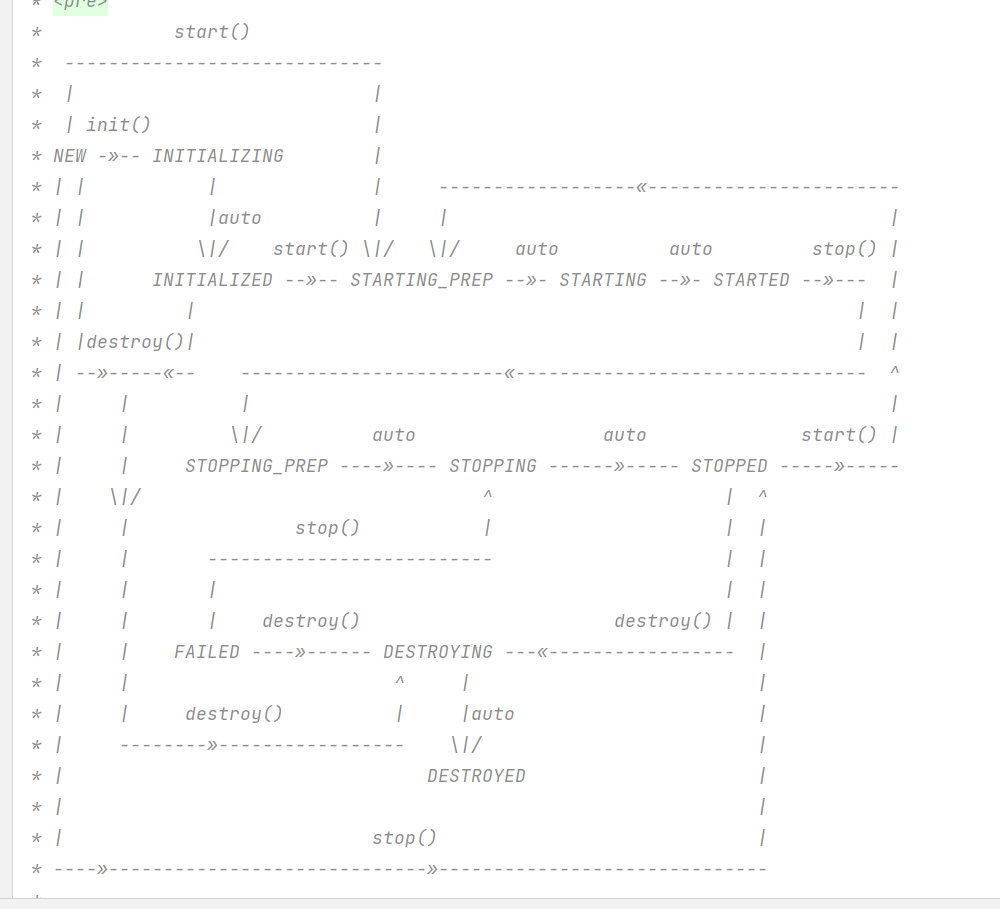Tomcat生命周期詳解
目錄
- 引言
- 1、LifeCycle接口設(shè)計(jì)
- 1.1 生命周期的方法
- 1.2 相關(guān)的狀態(tài)處理
- 2.監(jiān)聽器和事件的設(shè)計(jì)
- 3.LifecycleBase
- 3.1 事件處理
- 3.2 生命周期方法
引言
在上篇文章中我們看到了Tomcat架構(gòu)中的核心組件,而且各個(gè)組件都有各自的作用,各司其職,而且相互之間也有對(duì)應(yīng)的父子關(guān)系,那么這些對(duì)象的創(chuàng)建,調(diào)用,銷毀等操作是怎么處理呢?

也就是在Tomcat中的組件的對(duì)象生命周期是怎么管理的呢?針對(duì)這個(gè)問題,在Tomcat中設(shè)計(jì)了Lifecycle接口來統(tǒng)一管理Tomcat中的核心組件的生命周期,所以本文我們就系統(tǒng)的來介紹下Lifecycle接口的設(shè)計(jì)
1、LifeCycle接口設(shè)計(jì)
為了統(tǒng)一管理Tomcat中的核心組件的生命周期,而專門設(shè)計(jì)了LifeCycle接口來統(tǒng)一管理,我們來看看在LifeCycle接口中聲明了哪些內(nèi)容。
1.1 生命周期的方法
在LifeCycle中聲明了和生命周期相關(guān)的方法,包括init(),start(),stop(),destory()等方法。

在聲明的方法執(zhí)行的過程中會(huì)涉及到對(duì)應(yīng)的狀態(tài)的轉(zhuǎn)換,在LifeCycle接口的頭部文檔中很清楚的說了。

1.2 相關(guān)的狀態(tài)處理
通過上圖我們可以很清楚的看到相關(guān)的方法執(zhí)行會(huì)涉及到的相關(guān)狀態(tài)的轉(zhuǎn)換,比如init()會(huì)從New這個(gè)狀態(tài)開始,然后會(huì)進(jìn)入 INITIALIZING 和 INITIALIZED 等。因?yàn)檫@塊涉及到了對(duì)應(yīng)的狀態(tài)轉(zhuǎn)換,在Lifecycle中聲明了相關(guān)的狀態(tài)和事件的生命周期字符串。
public static final String BEFORE_START_EVENT = "before_start"; public static final String AFTER_START_EVENT = "after_start"; public static final String STOP_EVENT = "stop"; public static final String BEFORE_STOP_EVENT = "before_stop"; public static final String AFTER_STOP_EVENT = "after_stop"; public static final String AFTER_DESTROY_EVENT = "after_destroy"; public static final String BEFORE_DESTROY_EVENT = "before_destroy"; /** * The LifecycleEvent type for the "periodic" event. * 周期性事件(后臺(tái)線程定時(shí)執(zhí)行一些事情,比如:熱部署、熱替換) */ public static final String PERIODIC_EVENT = "periodic"; public static final String CONFIGURE_START_EVENT = "configure_start"; public static final String CONFIGURE_STOP_EVENT = "configure_stop";
在LifecycleState中建立了對(duì)應(yīng)關(guān)系

針對(duì)特定的事件就會(huì)有相關(guān)的監(jiān)聽器來監(jiān)聽處理。在Lifecycle中定義了相關(guān)的處理方法。
public void addLifecycleListener(LifecycleListener listener); public LifecycleListener[] findLifecycleListeners(); public void removeLifecycleListener(LifecycleListener listener);
通過方法名稱我們就能很清楚該方法的相關(guān)作用,就不過程介紹了。然后來看下對(duì)應(yīng)的監(jiān)聽器和事件接口的對(duì)應(yīng)設(shè)計(jì)。
2.監(jiān)聽器和事件的設(shè)計(jì)
接下來看下LifecycleListener的設(shè)計(jì)。其實(shí)代碼非常簡(jiǎn)單。
public interface LifecycleListener { /** * Acknowledge the occurrence of the specified event. * 觸發(fā)監(jiān)聽器后要執(zhí)行邏輯的方法 * @param event LifecycleEvent that has occurred */ public void lifecycleEvent(LifecycleEvent event);}然后來看下事件的接口
public final class LifecycleEvent extends EventObject { private static final long serialVersionUID = 1L; /** * Construct a new LifecycleEvent with the specified parameters. * * @param lifecycle Component on which this event occurred * @param type Event type (required) * @param data Event data (if any) */ public LifecycleEvent(Lifecycle lifecycle, String type, Object data) {super(lifecycle); // 向上轉(zhuǎn)型,可接受一切實(shí)現(xiàn)了生命周期的組件this.type = type;this.data = data; } /** * The event data associated with this event. * 攜帶的額外的數(shù)據(jù),傳遞給監(jiān)聽器的數(shù)據(jù) */ private final Object data; /** * The event type this instance represents. * 事件類型 */ private final String type; /** * @return the event data of this event. */ public Object getData() {return data; } /** * @return the Lifecycle on which this event occurred. */ public Lifecycle getLifecycle() {return (Lifecycle) getSource(); } /** * @return the event type of this event. */ public String getType() {return this.type; }}也是非常簡(jiǎn)單,不過多的贅述。
3.LifecycleBase
通過上面的介紹我們可以看到在Tomcat中設(shè)計(jì)了Lifecycle和LifecycleListener和LifecycleEvent來管理核心組件的生命周期,那么我們就需要讓每一個(gè)組件都實(shí)現(xiàn)相關(guān)的接口。這時(shí)你會(huì)發(fā)現(xiàn)交給子類的工作量其實(shí)是比較大的,不光要完成各個(gè)組件的核心功能,還得實(shí)現(xiàn)生命周期的相關(guān)處理,耦合性很強(qiáng),這時(shí)在Tomcat中給我們提供了一個(gè)LifecycleBase的抽象類,幫助我們實(shí)現(xiàn)了很多和具體業(yè)務(wù)無關(guān)的處理,來簡(jiǎn)化了具體組件的業(yè)務(wù)。

3.1 事件處理
在上面的接口設(shè)計(jì)中對(duì)于監(jiān)聽對(duì)應(yīng)的事件處理是沒有實(shí)現(xiàn)的,在LifecycleBase把這塊很好的實(shí)現(xiàn)了,我們來看下。首先定義了一個(gè)容器來存儲(chǔ)所有的監(jiān)聽器
// 存儲(chǔ)了所有的實(shí)現(xiàn)了LifecycleListener接口的監(jiān)聽器 private final List<LifecycleListener> lifecycleListeners = new CopyOnWriteArrayList<>();
同時(shí)提供了觸發(fā)監(jiān)聽的相關(guān)的方法,綁定了對(duì)應(yīng)的事件。
/** * Allow sub classes to fire {@link Lifecycle} events. * 監(jiān)聽器觸發(fā)相關(guān)的事件 * @param type Event type 事件類型 * @param data Data associated with event. */ protected void fireLifecycleEvent(String type, Object data) {LifecycleEvent event = new LifecycleEvent(this, type, data);for (LifecycleListener listener : lifecycleListeners) { listener.lifecycleEvent(event);} }已經(jīng)針對(duì)Listener相關(guān)的處理方法
// 添加監(jiān)聽器 @Override public void addLifecycleListener(LifecycleListener listener) {lifecycleListeners.add(listener); } // 查找所有的監(jiān)聽并轉(zhuǎn)換為了數(shù)組類型 @Override public LifecycleListener[] findLifecycleListeners() {return lifecycleListeners.toArray(new LifecycleListener[0]); } // 移除某個(gè)監(jiān)聽器 @Override public void removeLifecycleListener(LifecycleListener listener) {lifecycleListeners.remove(listener); }3.2 生命周期方法
在LifecycleBase中最核心的還是實(shí)現(xiàn)了Lifecycle中的生命周期方法,以init方法為例我們來看。
/** * 實(shí)現(xiàn)了 Lifecycle 中定義的init方法 * 該方法和對(duì)應(yīng)的組件的狀態(tài)產(chǎn)生的關(guān)聯(lián) * @throws LifecycleException */ @Override public final synchronized void init() throws LifecycleException {if (!state.equals(LifecycleState.NEW)) { // 無效的操作 只有狀態(tài)為 New 的才能調(diào)用init方法進(jìn)入初始化 invalidTransition(Lifecycle.BEFORE_INIT_EVENT);}try { // 設(shè)置狀態(tài)為初始化進(jìn)行中....同步在方法中會(huì)觸發(fā)對(duì)應(yīng)的事件 setStateInternal(LifecycleState.INITIALIZING, null, false); initInternal(); // 交給子類具體的實(shí)現(xiàn) 初始化操作 // 更新狀態(tài)為初始化完成 同步在方法中會(huì)觸發(fā)對(duì)應(yīng)的事件 setStateInternal(LifecycleState.INITIALIZED, null, false);} catch (Throwable t) { handleSubClassException(t, "lifecycleBase.initFail", toString());} }源碼解析:
- 我們看到首先會(huì)判斷當(dāng)前對(duì)象的state狀態(tài)是否為NEW,因?yàn)閕nit方法只能在NEW狀態(tài)下才能開始初始化
- 如果1條件滿足則會(huì)更新state的狀態(tài)為
INITIALIZED同時(shí)會(huì)觸發(fā)這個(gè)事件 - 然后initInternale()方法會(huì)交給子類具體去實(shí)現(xiàn),
- 等待子類處理完成后會(huì)把狀態(tài)更新為
INITIALIZED。
我們可以進(jìn)入setStateInternal方法查看最后的關(guān)鍵代碼:
// ....this.state = state; // 更新狀態(tài)// 根據(jù)狀態(tài)和事件的綁定關(guān)系獲取對(duì)應(yīng)的事件String lifecycleEvent = state.getLifecycleEvent();if (lifecycleEvent != null) { // 發(fā)布對(duì)應(yīng)的事件 fireLifecycleEvent(lifecycleEvent, data);}可以看到和對(duì)應(yīng)的事件關(guān)聯(lián)起來了。init方法的邏輯弄清楚后,你會(huì)發(fā)現(xiàn)start方法,stop方法,destory方法的處理邏輯都是差不多的,可自行觀看。
而對(duì)應(yīng)的 initInternal()方法的邏輯我們需要在 Server Service Engine Connector等核心組件中再看,這個(gè)我們會(huì)結(jié)合Tomcat的啟動(dòng)流程來帶領(lǐng)大家一起查看。
以上就是Tomcat生命周期詳解的詳細(xì)內(nèi)容,更多關(guān)于Tomcat生命周期的資料請(qǐng)關(guān)注其它相關(guān)文章!

 網(wǎng)公網(wǎng)安備
網(wǎng)公網(wǎng)安備